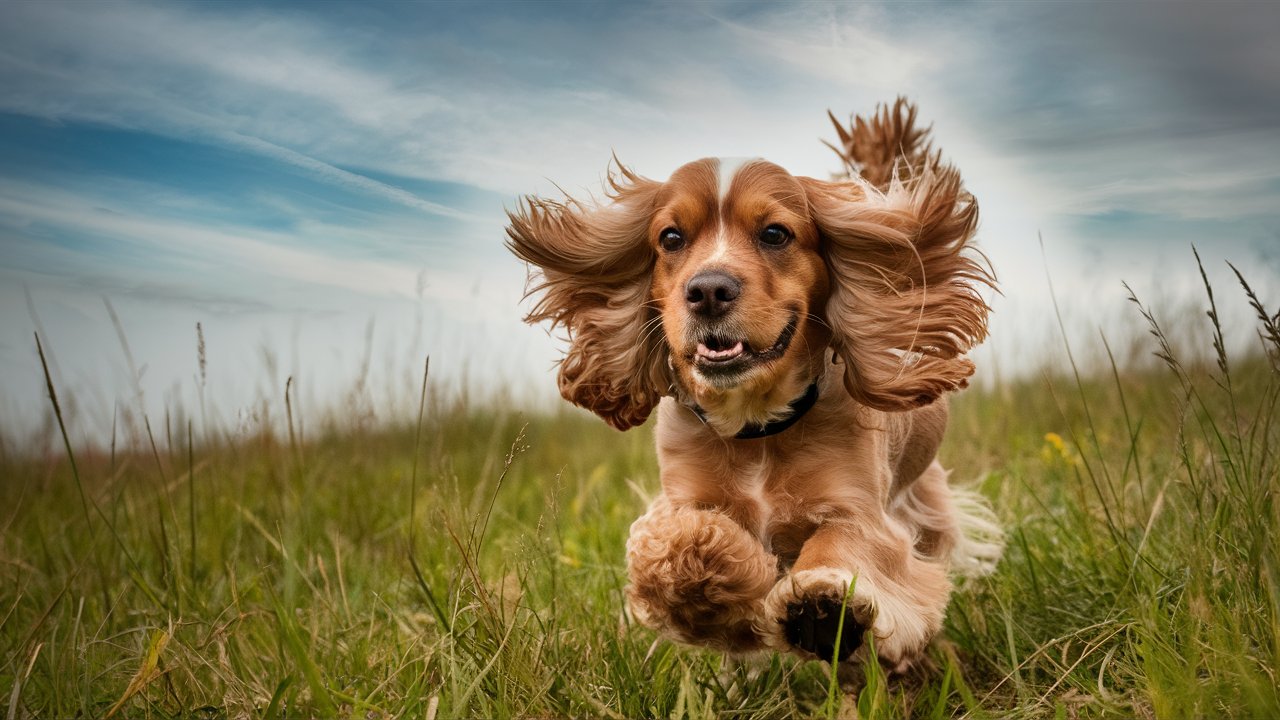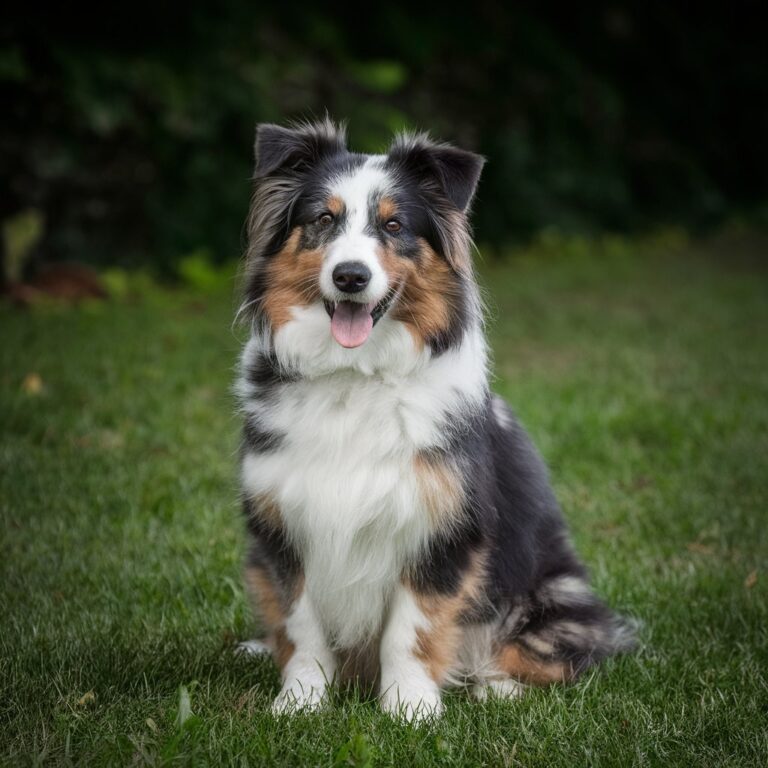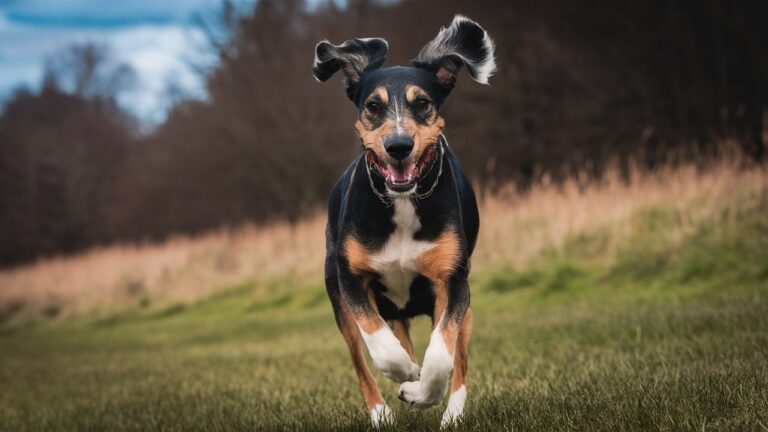The English Cocker Spaniel: 100% Comprehensive Guide
The English Cocker Spaniel is a breed that has captured the hearts of dog lovers worldwide with its charming personality, boundless energy, and striking appearance. This comprehensive guide delves into the history, characteristics, training, health care, and the unique bond you can develop with an English Cocker Spaniel. Through personal anecdotes and well-researched information, you’ll gain a deeper understanding of what makes this breed so special.
History and Origin

The Ancestry of the English Cocker Spaniel
The English Cocker Spaniel has a rich history dating back several centuries. Originally bred in England, this breed is a descendant of the spaniel family, which has been mentioned in literature as far back as the 14th century. Spaniels were primarily used as hunting dogs, prized for their ability to locate and retrieve game. The term “Cocker” is derived from their proficiency in hunting woodcock, a type of game bird.
Development of the Breed
By the 19th century, spaniels were classified by size rather than specific breeds. It wasn’t until the latter part of the century that distinct breeds, including the English Cocker Spaniel, began to emerge. The Kennel Club in the UK officially recognized the English Cocker Spaniel as a separate breed in 1892. Their popularity soared, particularly among hunters and aristocrats who valued their skills and affectionate nature.
Personal Anecdote: A Family Tradition
Growing up, my family had a tradition of owning English Cocker Spaniels. My grandfather, an avid hunter, always spoke fondly of his Cocker named Rusty. Rusty was not only an exceptional hunting companion but also a beloved family member. This personal connection to the breed has been passed down through generations, instilling a deep appreciation for these remarkable dogs.
Characteristics and Temperament
Physical Appearance
Dogs These Breed are medium-sized dogs, typically weighing between 26 to 34 pounds. They have a sturdy, compact build with a distinctive head featuring a square muzzle and expressive, dark eyes. Their long, feathered ears and wavy, silky coat are hallmarks of the breed. Coat colors vary widely, including solid black, liver, red, and various parti-color combinations.
Temperament and Personality
One of the most endearing qualities of the English Cocker Spaniel is their friendly and affectionate nature. They are known for their exuberant, tail-wagging greetings and boundless enthusiasm. These dogs are highly social and thrive on human interaction, making them excellent companions for families and individuals alike.
Intelligence and Trainability
English Cocker Spaniels are intelligent and eager to please, which makes training relatively straightforward. They respond well to positive reinforcement techniques, such as treats and praise. Early socialization and consistent training are crucial to ensure they develop into well-behaved, confident dogs.
Personal Anecdote: Training Challenges and Triumphs
When I first brought home my English Cocker Spaniel, Max, I quickly realized how intelligent and energetic he was. Training him was a rewarding yet challenging experience. I remember the first time he successfully retrieved a toy on command; the look of pride on his face was unforgettable. This journey of training Max not only strengthened our bond but also highlighted the importance of patience and consistency.
Health and Care

Common Health Issues
Like all breeds, English Cocker Spaniels are prone to certain health issues. Some of the most common include:
- Hip Dysplasia: A genetic condition where the hip joint doesn’t fit properly into the hip socket, leading to arthritis and pain.
- Ear Infections: Due to their long, floppy ears, Cocker Spaniels are susceptible to ear infections. Regular cleaning and check-ups can help prevent this.
- Progressive Retinal Atrophy (PRA): An inherited disease that leads to blindness. Regular eye check-ups are essential.
- Autoimmune Hemolytic Anemia (AIHA): A condition where the immune system attacks the body’s red blood cells.
Preventative Care and Maintenance
Regular veterinary check-ups, a balanced diet, and proper grooming are essential to keeping your English Cocker Spaniel healthy. Here are some key aspects of their care:
- Diet and Nutrition: Feed your dog a high-quality, balanced diet that meets their nutritional needs. Avoid overfeeding to prevent obesity, which can exacerbate joint problems.
- Exercise: English Cocker Spaniels are energetic dogs that require regular exercise. Daily walks, playtime, and mental stimulation are crucial to their well-being.
- Grooming: Their wavy, silky coat requires regular grooming to prevent matting and tangles. Brush your Cocker at least three times a week and consider professional grooming every few months.
Personal Anecdote: The Grooming Routine
Grooming Max has become a cherished routine for us. Although he initially resisted the brushing sessions, he gradually grew to enjoy them. It’s a special bonding time where he relaxes and I get to ensure his coat remains healthy and tangle-free. This routine has not only kept him looking his best but also reinforced our connection.
Training and Socialization
Basic Training Tips
Training an English Cocker Spaniel should begin as early as possible. Here are some basic tips to get started:
- Positive Reinforcement: Use treats, praise, and affection to reward good behavior. Avoid harsh corrections, as these can lead to fear and anxiety.
- Consistency: Be consistent with commands and rules. Mixed signals can confuse your dog and hinder the training process.
- Socialization: Expose your puppy to different people, environments, and other animals to build confidence and prevent behavioral issues.
Advanced Training and Activities
Once your dog has mastered basic commands, you can move on to more advanced training and activities. English Cocker Spaniels excel in various dog sports and activities, such as:
- Agility: This high-energy sport involves navigating an obstacle course and is perfect for the agile and enthusiastic Cocker.
- Obedience: Advanced obedience training can improve your dog’s behavior and enhance your communication with them.
- Hunting and Retrieving: For those interested in hunting, Cocker Spaniels can be trained to retrieve game, showcasing their natural abilities.
Personal Anecdote: Agility Training Adventures
One of the most rewarding experiences with Max has been participating in agility training. His natural agility and eagerness to learn made him a star on the course. I vividly remember the first time he completed the entire course without a mistake; his joy was palpable, and so was mine. Agility training not only kept him physically fit but also mentally stimulated and happy.
Living with an English Cocker Spaniel

Family Life
English Cocker Spaniels are known for their affectionate and social nature, making them ideal family dogs. They are gentle, loving, and patient, traits that make them particularly well-suited for homes with children. Their playful energy and curiosity match well with the enthusiasm of kids, creating a harmonious and joyful environment.
Interacting with Children
When introducing an English Cocker Spaniel to a household with children, it’s important to set boundaries and teach both the dog and the children how to interact respectfully. Supervision during playtime is crucial to ensure that neither the dog nor the children get overwhelmed or overly excited. Educate children on the proper way to approach and handle the dog, emphasizing gentle petting and avoiding actions that could startle or hurt the dog.
Personal Anecdote: One of my favorite memories with Max was watching him play with my niece. She was initially a bit scared of dogs, but Max’s gentle and patient demeanor quickly won her over. They would spend hours playing fetch in the yard, and Max seemed to instinctively understand when to be more gentle and when to amp up the playfulness.
Interaction with Other Pets
English Cocker Spaniels generally get along well with other pets, especially when they are socialized from a young age. They are not overly dominant and can coexist peacefully with other dogs and even cats. Early socialization and gradual introductions are key to fostering positive relationships between your Cocker Spaniel and other animals in your household.
Tips for Multi-Pet Households
- Gradual Introductions: Allow your pets to meet in a controlled and neutral environment. Gradually increase the amount of time they spend together as they become more comfortable.
- Positive Reinforcement: Reward all pets with treats and praise when they interact calmly and positively with each other.
- Separate Spaces: Ensure each pet has its own space where it can retreat and feel safe. This can help reduce potential conflicts over territory.
Personal Anecdote: When I adopted a rescue cat, Luna, I was initially worried about how Max would react. To my surprise, after a few days of cautious sniffing and observing, they became inseparable. Watching them nap together on the couch is a testament to the adaptability and social nature of English Cocker Spaniels.
Living Arrangements
Ideal Home Environment
English Cocker Spaniels are adaptable dogs that can thrive in various living environments, provided their exercise and social needs are met. While they enjoy having a yard to play in, they can also live happily in apartments or smaller homes as long as they receive regular walks and mental stimulation.
Apartment Living
For those living in apartments, it’s essential to commit to daily walks and play sessions to keep your Cocker Spaniel healthy and happy. Interactive toys, puzzle feeders, and training sessions can provide additional mental stimulation, preventing boredom and destructive behavior.
Personal Anecdote: Transitioning from a house with a yard to an apartment with Max required some adjustments. We established a routine of morning and evening walks and discovered a nearby dog park where he could run off-leash. These outings became highlights of our day, allowing Max to burn off energy and socialize with other dogs.
Daily Routine and Care
Exercise Needs
English Cocker Spaniels are energetic dogs that require regular exercise to stay fit and healthy. Aim for at least an hour of physical activity each day, which can include walks, playtime, and engaging in dog sports such as agility or obedience training.
- Walks: Daily walks are essential. Vary the routes to keep things interesting and provide new sights and smells for your dog to explore.
- Playtime: Interactive games like fetch, tug-of-war, and hide-and-seek can be great ways to keep your dog physically and mentally stimulated.
- Dog Sports: Consider participating in dog sports that cater to the breed’s natural abilities, such as agility, obedience, and field trials.
Personal Anecdote: One of Max’s favorite activities is our weekend hikes. Exploring trails and encountering new environments keeps him engaged and happy. Plus, it’s a great way for both of us to get exercise and enjoy the outdoors together.
Mental Stimulation
Mental stimulation is just as important as physical exercise for English Cocker Spaniels. These intelligent dogs thrive on activities that challenge their minds.
- Training Sessions: Regular training sessions can keep your dog’s mind sharp and reinforce good behavior.
- Puzzle Toys: Interactive puzzle toys and treat-dispensing toys can provide mental stimulation and keep your dog entertained.
- New Experiences: Exposing your dog to new experiences, whether it’s a new walking route, a visit to a different park, or meeting new people and dogs, can keep their mind engaged.
Personal Anecdote: I invested in a variety of puzzle toys for Max, and it’s always a delight to watch him figure them out. The concentration and determination on his face are endearing, and it’s clear these toys provide valuable mental exercise.
Grooming and Maintenance
Coat Care
The English Cocker Spaniel’s coat requires regular grooming to maintain its health and appearance. Their long, silky fur can become matted and tangled if not properly cared for.
- Brushing: Brush your dog’s coat at least three times a week to prevent tangles and mats. During shedding season, more frequent brushing may be necessary.
- Bathing: Bathe your dog every 4 to 6 weeks, or as needed, using a dog-specific shampoo to keep their coat clean and shiny.
- Professional Grooming: Regular visits to a professional groomer can help manage the coat, particularly for trimming and styling.
Personal Anecdote: Max loves his grooming sessions, especially the brushing part. It’s become a calming routine for both of us. I’ve learned to be meticulous with his ear care, as his long ears are prone to infections if not kept clean and dry.
Ear Care
English Cocker Spaniels are prone to ear infections due to their long, floppy ears, which can trap moisture and debris.
- Regular Cleaning: Clean your dog’s ears weekly using a vet-recommended ear cleaner. Avoid using cotton swabs, which can push debris further into the ear canal.
- Check for Infections: Regularly check for signs of ear infections, such as redness, swelling, or a foul odor. If you notice any of these symptoms, consult your veterinarian promptly.
Personal Anecdote: I’ve had to be particularly diligent about Max’s ear care. After a minor ear infection scare, I established a routine of weekly cleanings, which has kept his ears healthy and infection-free.
Creating a Safe and Enriching Environment
Safe Spaces
Providing your English Cocker Spaniel with a safe space where they can retreat and relax is important. This could be a cozy bed in a quiet corner of the house or a crate where they feel secure.
- Crate Training: If used appropriately, a crate can be a comforting and safe space for your dog. Ensure it’s large enough for them to stand, turn around, and lie down comfortably.
- Comfort Items: Include comfort items like a favorite blanket, toys, and chew items to make their space inviting.
Home Safety
Ensure your home is safe for an energetic and curious dog. Secure household items that could be harmful, such as cleaning supplies, electrical cords, and small objects that could be swallowed.
- Pet-Proofing: Pet-proof areas where your dog has access, much like you would for a toddler.
- Supervision: Always supervise your dog when they are exploring new areas of your home or yard to prevent accidents.
Personal Anecdote: Max has a favorite spot by the window where he loves to lounge and watch the world go by. We set up a comfortable bed there, and it’s become his go-to place for relaxation. Ensuring this spot is safe and comfortable has given him a sense of security and routine.
Travel and Adventures
Traveling with Your Cocker Spaniel
English Cocker Spaniels are generally good travelers and enjoy accompanying their families on adventures. Whether it’s a road trip, a visit to a friend’s house, or a vacation, here are some tips for smooth travels:
- Crate or Harness: Use a secure crate or a dog-specific seatbelt harness to keep your dog safe during car rides.
- Frequent Breaks: On long trips, take regular breaks to allow your dog to stretch, relieve themselves, and have a drink of water.
- Familiar Items: Bring along familiar items such as their bed, toys, and food to make them feel more comfortable in new environments.
Personal Anecdote: Max is an excellent travel companion. Our road trips are filled with adventures, and he loves exploring new places. Having his favorite blanket and toys on hand has always helped him feel more at ease during our journeys.
Outdoor Adventures
English Cocker Spaniels thrive in outdoor activities and enjoy exploring nature. Whether it’s hiking, swimming, or simply playing fetch in the yard, these activities cater to their energetic and curious nature.
- Hiking: Ensure your dog is fit for hiking and start with shorter trails. Bring plenty of water and take breaks as needed.
- Swimming: Many Cocker Spaniels enjoy swimming. Always supervise your dog near water and ensure they are comfortable and safe.
- Dog Parks: Regular visits to dog parks can provide excellent socialization opportunities and a chance for your dog to run off-leash in a safe environment.
Personal Anecdote: One of our favorite activities is hiking. Max’s enthusiasm for hitting the trails is contagious. Watching him navigate the paths, sniffing every interesting scent, and joyfully splashing in streams is a reminder of the simple pleasures of life.
Emotional Well-Being
Companionship and Bonding
English Cocker Spaniels form strong bonds with their owners and can experience separation anxiety if left alone
Health and Lifespan

Longevity
The average lifespan of an English Cocker Spaniel is between 12 to 15 years. With proper care, some can live even longer. Ensuring your dog leads a healthy lifestyle with regular vet visits, a balanced diet, and adequate exercise is key to longevity.
Senior Care
As your Cocker Spaniel ages, their needs will change. Here are some tips for caring for a senior dog:
- Diet: Adjust their diet to meet the nutritional needs of an older dog. Senior dog food formulas are available that cater to their specific requirements.
- Exercise: While they may not have the same energy levels as in their younger years, regular, gentle exercise is still important.
- Health Monitoring: Keep an eye on any changes in behavior, appetite, or mobility. Regular vet check-ups are crucial to managing age-related health issues.
Personal Anecdote: Caring for an Elderly Companion
As Max entered his senior years, we made several adjustments to ensure his comfort. We switched to a senior dog food formula and provided him with a soft, orthopedic bed. Although his energy levels decreased, he still enjoyed our daily walks, albeit at a slower pace. These changes helped him maintain a good quality of life in his golden years.
The Unique Bond with an English Cocker Spaniel
Emotional Connection
One of the most rewarding aspects of owning an English Cocker Spaniel is the deep emotional bond that forms between you and your dog. Their loyalty, affection, and intuitive nature create a strong connection that is truly special.
Personal Stories of Companionship
I vividly remember a particularly challenging time in my life when Max’s unwavering support and affection made all the difference. His presence provided comfort and a sense of stability. This experience reinforced my belief in the profound impact a dog can have on one’s emotional well-being.
Building a Lifelong Friendship
Owning an English Cocker Spaniel is a long-term commitment that brings immense joy and companionship. By providing them with love, care, and attention, you can build a lifelong friendship that enriches both your lives.
Conclusion
The English Cocker Spaniel is a remarkable breed known for its friendly temperament, intelligence, and versatility. From their historical roots as skilled hunting dogs to their modern roles as beloved family pets, Cocker Spaniels continue to capture the hearts of dog enthusiasts around the world. Through proper care, training, and companionship, you can ensure a fulfilling and joyful life with your English Cocker Spaniel.
Whether you’re considering adding an English Cocker Spaniel to your family or already have one, this comprehensive guide offers valuable insights and personal anecdotes to help you understand and appreciate this wonderful breed. The bond you create with your Cocker Spaniel will undoubtedly be one of the most rewarding experiences of your life.





